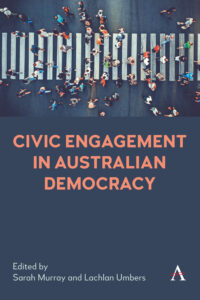This is an interview with Sarah Murray and Lachlan Umbers, editors of Civic Engagement in Australian Democracy
What inspired this edited collection on Civic Engagement in Australian Democracy?
Australian democracy depends fundamentally upon an active, engaged citizenry. In this respect, however, Australian democracy appears to be in decline. The percentage of citizens on the electoral roll who participated in the last election was below 90% for the first time since the introduction of compulsory voting in the 1920s. The ways in which Australians participate in Australian democracy are also changing. Australia has also witnessed a number of historically rare opportunities for direct participation in the lawmaking process – particularly, the 2017 same-sex marriage plebiscite, and the 2023 referendum on the Aboriginal and Torres Strait Islander Voice to Parliament. These developments raise deep, difficult questions for Australian democracy, many of which have been under-explored. What, for instance, does the failure of the Voice referendum mean for Australian democracy? What sorts of opportunities ought to be afforded to Australians for direct participation in government? How might climate change affect Australian democracy in the coming decades? This edited collection brings together specialists in the democratic process to consider such questions, alongside many others.
Can you give a sense of the breadth of the chapters it showcases?
Most certainly. The work explores issues such as contemporary voting in Australia with chapters on compulsory voting, early voting as well as direct participation through plebiscites and the scope and ‘unstable foundations’ of the implied freedom of political communication. It also has three chapters devoted to the 2023 Aboriginal and Torres Strait Islander Voice to Parliament referendum which was unsuccessful in enshrining an Aboriginal and Torres Strait Islander Voice in the Australian Constitution. Other chapters focus on declining participation in civil society, civic engagement among the Australian African diaspora, the potential for citizens as custodians of unwritten governmental norms and the potential disruptive nature of climate change on Australian politics.
What are some key lessons from the book for Australian democracy?
It is really hard to focus on only some lessons when the book provides such a tapestry of lessons for Australian democracy. However, understanding the radically altered media landscape is one key lesson and is the subject of the Carson, Hayman and Phillips’s chapter. Through the lens of the 2023 Voice to Parliament referendum, the chapter showcases how civic engagement with information is changing and how future political contests might play out online. Similarly, Fozdar et al.’s chapter on the civic life of African Australians provides important insights to a previously under-explored area of Australian politics. Important lessons also derive from Tham’s contribution on climate change. His chapter explores the complex dynamic between Australian politics’ slow response to climate change while climate change presents a wicked problem amounting to a threat to democracy itself.
What disciplinary perspectives does the book draw upon it?
One of the particular strengths of the collection is that it is uniquely interdisciplinary, insofar as the contributors are drawn from a diverse range of fields – law, philosophy, political science, journalism and sociology. The chapters each help bring us a broader understanding of civic participation in Australian democracy, in order that we might evaluate the status quo, and gauge where it might be headed, in the future.
Who do you think the collection will be of particular interest to?
The book is primarily aimed at an academic audience in fields such as political science, law, history, sociology, journalism and philosophy. Given the topicality of the issues discussed in the book, it is reasonable to expect it to be a valuable resource for undergraduate teaching (particularly in political science, journalism and law), further expanding the potential market for the book. Australian politics is also of significant interest to the public and policymakers, more generally, such that it is reasonable to expect that there would be at least some interest in the book from a more general, non-academic readership.
Does the book have practical policy relevance?
The Australian democratic system has long been regarded as one of the most stable and predictable in the world. This is largely because of its entrenched two-party duopoly, compulsory voting and relatively high levels of satisfaction with the democratic process. These have, however, started to lose some of their salience as the ways Australians engage with, and participate in, their democracy have shifted substantially in recent times. It is for this reason that this book is particularly important to policymakers to help understand the complexity of civic engagement in Australian democracy and how long-standing assumptions might not hold sway any more.

